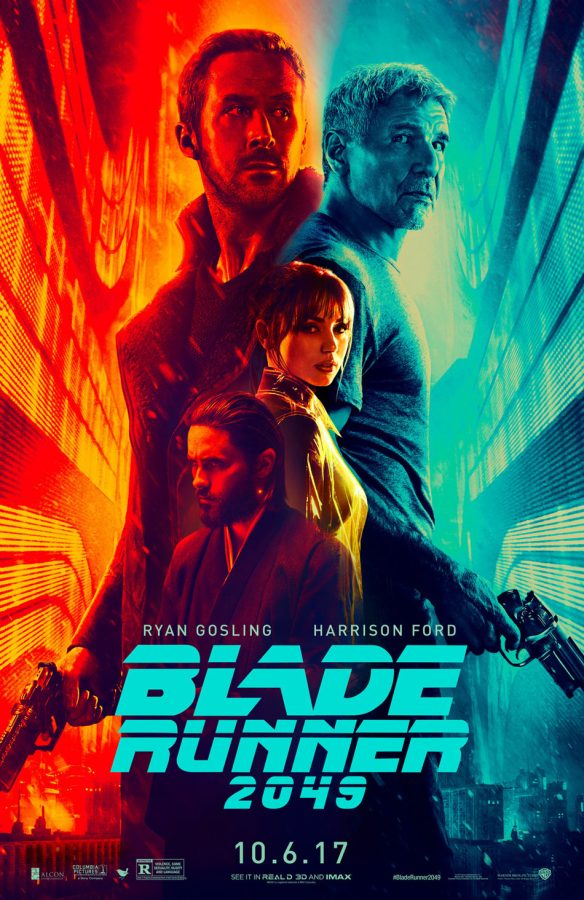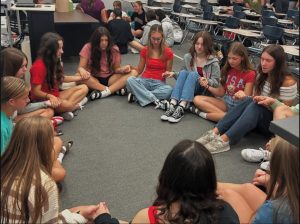Bladerunner 2049 a masterpiece of art and philosophy
November 21, 2017
Blade Runner 2049 is the sequel to Ridley Scott’s 1982 film Blade Runner, a film that became a major influence on all sci-fi movies that came after it. Set 35 years after the original, the film stars Ryan Gosling as Agent K, a “blade runner” tasked with hunting down and killing dangerous replicants (powerful, human-like androids, created to work as slave labor).
After K discovers a long hidden secret, he begins on a journey to uncover the truth about his world and the society around him. His journey brings him into contact with Deckard, a former blade runner (Harrison Ford reprising his role as the main character of the 1982 original), Niander Wallace, a sinister business man with a god complex who designs replicants, played by Jared Leto, and Luv, a mercenary replicant who works for Wallace. Ana de Armas, Robin Wright, and Dave Bautista also play supporting characters Joi (K’s girlfriend), Lt. Joshi (K’s boss), and Sapper Morton (a replicant K investigates), respectively.
From the first few frames, Blade Runner 2049 grabs your attention and never lets go. It’s opening shots establish a world that is barren and for the most part abandoned by humanity. Wide shots of the Earth showcase the wide scope of this world, much larger than we ever see on screen, yet we as an audience know still exists somewhere. The vastness of 2049’s world is breathtaking and daunting, a dark, dystopian future that no longer seems as impossible as it did 35 years ago. This world is an organic evolution of the world seen on screen in 1982, improving on technologies that were present in the original, yet refraining from adding technology that exists in our society.
Blade Runner 2049’s world is set in the future of Ridley Scott’s techno-dystopia, not our real world that is a relative utopia. Elaborate practical sets make up the cities and remote locations, showcasing tiny details that are enhanced by breathtaking CGI. The neon lights of future Los Angeles are intoxicatingly bright and they pull you into the screen, beckoning to you to join this future of bright excess. Roger Deakins, the legendary cinematographer, turns in his best work yet, capturing all the bright colors of this futuristic world, yet also allowing for the inherent darkness to seep in and take over when necessary.
Each location feels fully realized and lived-in, and a lot of that is in thanks to Deakins. His wide shots of vast landscapes and cityscapes are truly awe inspiring and beautiful. Practically every shot in this nearly 3 hour film is worthy of being framed, and if Deakins’ work here doesn’t finally earn him his long deserved Oscar, then nothing ever will. The way he frames characters in order to tell a story without them ever having to speak a word is truly masterful and he is clearly at the top of his game with 2049.
Visuals alone are not capable of holding an audience’s attention for 2 hours and 40 minutes; in order for the movie to work, its story must also be engrossing and capable of interesting an audience. Blade Runner 2049 scores another home run in this department, delivering a story that is captivating and fresh, while at the same time feeling like a natural evolution and expansion of the story and themes from the original.
Once again, questions about what makes humanity are central to the plot, and they are just as unanswerable as they were in 1982. Just as Ford’s Deckard battled with the idea of possibly being something “more than human” in the original, Gosling’s K grapples with the idea that he is not who he thinks he is, and each twist and turn in the plot leads the audience to believe they are learning more and more about who he really is. K’s quest to uncover the truth about himself as well as his world is captivating because of these supposed reveals, allowing the audience to believe they know everything when they in fact know nothing. They become emotionally invested in his story because they are learning about the character at the same time that he is. Overall, the story here feels much more focused on achieving a more specific goal than the original did. Even though it features more twists and turns, it is less confusing and more satisfying by the end.
Ryan Gosling’s performance is central to the success of Blade Runner 2049, and he delivers a quiet, subdued performance that relies more on his expressions than his words to tell a story. His eyes reveal a sadness and world-weariness that comes with his character’s job and life, and they tell a lot about his character as he learns about himself. Harrison Ford’s Deckard is completely different from the cold, hardened cop we knew in the original.
Instead, this Deckard is old and tired of the world, haunted by his past and unable to move on from events that took place between both movies. He lives on his own in an abandoned city, drinking and reading all day to try to drown the ghosts of his past. It’s depressing to see a hero like this, but it’s essential to understand that he’s human too, even if there are hints that he isn’t one. Leto’s sinister Wallace is frightening and genuinely disturbing, and although he isn’t in much of the movie, his presence looms large throughout.
The movie was directed by Québécois filmmaker Denis Villeneuve (Arrival, Prisoners), although Ridley Scott, the director of the original film as well as movies like Alien and The Martian, served as a producer and advisor on the film.
This movie is labeled an action film, yet there isn’t much action actually in the film. Over the 160 minutes the movie runs, there are maybe three legitimate fight sequences with several smaller sequences sprinkled in. Instead, this movie decides to focus on character and story, something that is clearly a deliberate choice, and an effective one too. Instead of this movie serving as a sequel meant to kickstart a new mainstream action “Blade Runner Cinematic Universe” like many studios have been attempting recently, this movie sticks to its roots and tells a “Blade Runner” story that is self-contained and meant to stand alone.
In the few action scenes that do exist, however, the action is brutal and extremely violent. It is hard-hitting and extremely affecting to the audience. Every hit felt real and the visceral images that play out onscreen induce winces. These scenes are accentuated by Hans Zimmer’s blaring score, almost a callback to his score from Inception. The music is loud and in your face, just like the action is meant to be, and their marriage on screen is perfect. The atmospheric nature of the score is just another element that draws the audience into the film, and it also serves as a callback to the phenomenal score by Vangelis from the original.
The only real thing that can be seen as a problem in this movie is its runtime, which is 160 minutes long; almost 3 hours long. Three hours is a lot to ask of an audience, yet for a Blade Runner movie, it’s appropriate. Every scene feels essential and looking back, it doesn’t make sense to remove any of them.
Blade Runner 2049 is a modern masterpiece, a shining example of why people love to make and watch movies. The questions it raises about the importance of humanity are ones that are slowly becoming relevant to our society today. It is a movie for reflection, yet it manages to feature engaging action set pieces as well. It is a continuation of the classic original that feels very natural and organic, featuring callbacks in everything, including the score, themes, the plot, and the visuals. Blade Runner 2049 is a must see for anyone and everyone, especially those who wonder why film is such an inspiring medium.








